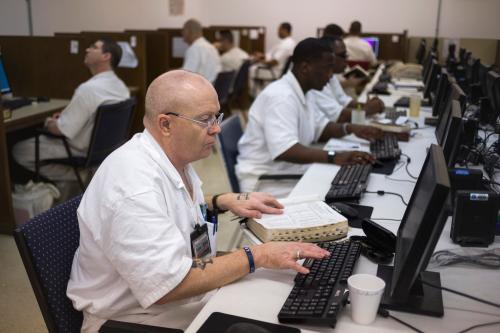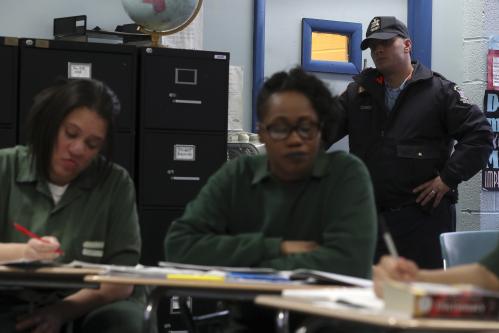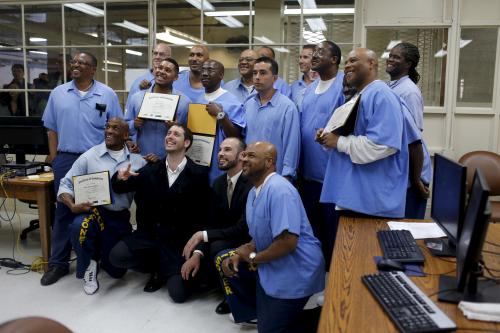As of July 2023, incarcerated students are again eligible for Pell Grants to support their enrollment in approved prison education programs (PEPs). This major policy shift comes after a widespread “Second Chance Pell Experiment” in which the Department of Education invited colleges to pilot using federal financial aid at state and federal prisons. Between 2016 and 2022, the program awarded aid that enabled students to earn almost 12,000 credentials, with many students still enrolled and completing degree requirements.
The recent federal aid expansion gives broad authority to the states to decide how to approve and evaluate aid-eligible prison education programs. There remain open questions about how to balance accountability goals while ensuring vulnerable students have equitable access to high-quality instructional programs. The Brown Center on Education Policy invited four experts to weigh in on these questions: Erin Castro, associate professor of higher education at the University of Utah and co-founder of the University of Utah Prison Education Project; Marc Howard, professor of government and law and director of the Prisons and Justice Initiative at Georgetown University; and from the Tennessee Higher Education in Prison Initiative, Laura Ferguson Mimms, executive director, and Rachel Zolensky, vice president of strategy and impact.
What do we expect the impact of Pell Grant expansion to be on prison education enrollment?
Marc Howard
The expansion of Pell Grants is just beginning to rectify some of the damage caused by the near-total elimination of higher education programs in prison after 1994. For nearly 30 years, incarcerated people have had extremely limited access to college, leaving them with almost no avenues to pursue a higher education. We can’t even begin to measure the negative impact of decades’ worth of lost opportunities.
With the restoration and expansion of Pell to incarcerated students, the Department of Education estimates that 760,000 people will be newly eligible for federal financial aid. We know from our own experience accepting applications for Georgetown’s Bachelor of Liberal Arts program in Maryland that the demand for such programs is huge, so I expect that there will be no shortage of intelligent, curious, engaged students ready to jump at the chance to continue their education.
And we know that taking even one college course while incarcerated cuts the chances of a person ending up back in prison by about half. Since 95 percent of incarcerated people will return home at some point, it’s in everyone’s best interest to ensure that they return with more skills and education. Beyond the effects on recidivism, joining a postsecondary education program builds self-confidence, communication, and engagement with peers, while also empowering students as role models, leaders, and engaged citizens.
Erin Castro
We’ve already seen an enormous growth in both the number of incarcerated students enrolled and the institutions of higher education choosing to participate. Our team at the Research Collaborative counted at least 354 unique colleges and universities serving incarcerated learners in 2018, compared to at least 572 in 2021. This growth is unprecedented post-1994, and all evidence points to these numbers continuing to soar.
Unfortunately, I anticipate that we will also see the inequality persistent across higher education replicated inside prisons if we do not proactively work against norms of racism, classism, ableism, sexism and similar patterns of bias. For example, in the 2015-16 school year, the percentage of students who received Pell Grants was highest for Black students. Yet, during the Second Chance Pell Experiment, the largest share of recipients of the Pell Grant were incarcerated white men. What is being done to ensure that racial inequality is not exacerbated in prison higher education via the distribution of federal student aid?
It’s also important to note that most credentials conferred to incarcerated people during the Second Chance Pell Experiment are short-term credentials such as certificates of completion and career and technical education awards. By and large, incarcerated students do not have options to stack these credentials into degree pathways. This is a problem for equity and quality and flies in the face of available evidence and effective practices.
The expansion of Pell Grants provides support for the financial barriers to incarcerated people taking postsecondary courses. What are other barriers to a college education incarcerated students face, and what are successful strategies to help students overcome those barriers?
Erin Castro
Incarcerated people face incredible, often insurmountable, barriers to fully participating in postsecondary education. We are talking about a group of people for whom postsecondary education remains largely out of reach. Many incarcerated people are first-generation students, post-traditional students, Veterans, parents, students with disabilities, students of color, and/or low-income students. The failures of colleges and universities in serving these populations on the outside are only exacerbated in the prison environment, where deprivation and censorship of information threaten equity and quality.
In our research on Second Chance Pell, we found that information deprivation and censorship lead to incarcerated borrowers making uninformed financial decisions (to no fault of their own) that can have detrimental impacts for their college experience and financial futures. Higher education administrators supporting college students in prison must ensure incarcerated students have access to accurate and timely information regarding cost of attendance and financial aid, and that they are able to ask questions and receive timely answers from professionals.
Higher education administrators, specifically those in offices of financial aid, must reach incarcerated students with accurate information as they would any other student population. Departments of corrections, prison education program staff, and higher education administrators must help facilitate these interactions. This proactive approach includes being transparent about how Pell and other funds are being spent by the institution of higher education, and the conditions under which students are agreeing to receive aid.
Rachel Zolensky
Some of the barriers are administrative. To access accredited and degree-granting higher education programs, incarcerated prospective students must provide admissions and financial aid offices with certain records. While providing prior college transcripts or proof of citizenship may seem innocuous, records requests like these can place a significant burden on incarcerated people. For example, an incarcerated college applicant will likely be unable to: access the internet to place an order online or to lookup a mailing address; make a timely phone call to place an order or request information; send or receive an email; possess or send a copy of official identification; make payments via credit card or cashier’s check; and visit an office in person to request additional help.
Locating and procuring student records on behalf of incarcerated students requires a considerable investment of time and effort. Colleges are unaccustomed to taking on this work, leaving the responsibility to family members or prison staff. This challenge raises many of the same equity and access concerns that led to a recent policy from the U.S. Department of Education seeking to remove barriers for students unable to access their previous college transcripts due to financial debt. Colleges and departments of corrections may need to work together to establish pathways for students to procure records, which may require state or institutional policy changes (e.g., if a college is barred from purchasing a student record, or if a prison is unable to issue a state ID).
The FAFSA Simplification Act defined each State Department of Corrections as the primary oversight entity for prison education programs (PEP). How should these oversight entities evaluate whether an eligible PEP is operating in the best interest of students?
Laura Ferguson Mimms
Colleges and universities must ensure that students have an academically rigorous educational experience, with the support and opportunities for self-exploration and development available to non-incarcerated students. While this responsibility falls to the college/university, accountability falls to the oversight entity. Oversight entities must expand their normal scope of determining program effectiveness beyond measures related to safety and security, and instead measure success using student success measures (e.g., the Alliance for Higher Education in Prison Equity and Excellence in Practice, Institute for Higher Education Policy Higher Education in Prison Key Performance Indicator Framework, and state-specific quality assurance frameworks). Moreover, oversight entities must proactively engage with currently and formerly incarcerated stakeholders to not only ensure programs clearly articulate the services and supports they intend to provide but to ensure programs walk out the words articulated in their PEP application. In sum, oversight entities must be knowledgeable about meaningful postsecondary metrics, require potential PEPs to meet or exceed these metrics, and utilize ongoing feedback and assessment to ensure programming is operated in the best interest of students.
Erin Castro
I do not think that State Departments of Corrections have the expertise nor bandwidth to serve in this capacity. But the legislation is law. Individual states, regional alliances, and organizations that provide technical assistance to Departments of Corrections are making some positive progress in this space, from which I think we can learn and hopefully scale.
The Department of Education chose four metrics to assess the best interest of students, all of which can be achieved with wildly different degrees of quality. This means that what we consider in the “best interest of students” could very well be—and in many places, is—radically different from what is provided on college and university campuses, both theoretically and materially. At the heart of evaluating whether what is provided is in the best interest of students, is a deeply philosophical question (and commitment) to what we think incarcerated people deserve. Short-term credentials with little market value, for example, meet the threshold of the best interest standard. The question then becomes: does it meet our standard for what we would provide to our children? Our family? Our community?
Deference to departments of corrections on behalf of college and university staff is one of the biggest detriments to ensuring high quality experiences for incarcerated students. Sure, some things cannot be done in a prison, but examples of high impact practices exist throughout this field and because of persistence, curiosity, and imagination on behalf of incarcerated students and non-incarcerated staff. It is the responsibility of non-incarcerated practitioners in higher education to ensure that incarcerated students have access to what they need to be successful. Decades of research help us know what makes higher education impactful for students, and what students need to be successful. PEPs should strive to provide incarcerated students with high-impact practices such as integrated learning opportunities, collaborative projects, research experiences, and first-year seminars, just as they do non-incarcerated students.
Rachel Zolensky
With Departments of Corrections now responsible for evaluating students’ best interest in PEPs, it’s possible that indicators for high-quality PEPs will begin to mirror the competencies and priorities of carceral institutions rather than indicators traditionally held by institutions of higher education for best practices in teaching and learning. For example, student access to information may cease to be prioritized as an integral marker of high-quality PEPs, to the detriment of students. To counteract this possibility, oversight entities should compile diverse groups of their stakeholders, including formerly incarcerated people and higher education leaders in their state, to engage in the creation of the standards against which PEP programs will be evaluated and held.
How can colleges design accessible and effective prison education programs? What state or federal policies could facilitate developing successful PEPs?
Laura Ferguson Mimms
If you want to design an educational program that is both accessible and effective for a specific population, you would be remiss if you did not carefully consider, consult, and concentrate your efforts on understanding, engaging, and building supports for that population. This is the charge that colleges and universities wanting to serve as PEPs must undertake in serving incarcerated individuals. Current policy places determination of PEP effectiveness at the feet of oversight entities. However, we should place more power in determination of effectiveness, or lack thereof, in the hands of the individuals engaging in PEPs.
Erin Castro
Any educational practice or policy in prison higher education must be made within the context of structural inequality that pervades the field. Our research has found that incarcerated students do not have access to accurate information from their college or university about why they are eligible for Pell, how funding is being expensed, and other critical information about cost of attendance. Their skepticism regarding how colleges and universities spend their Pell dollars is justified, as are their calls for greater transparency and information regarding FAFSA completion, tuition and fees, equipment charges, and cost of attendance. Accessible and effective PEPs must account for this reality and the fact that “college choice” is a myth for students who are incarcerated. Many students are spending down their Pell Grant lifetime eligibility on credential pathways that, if afforded other options, may choose differently.
Marc Howard
A prison education program can’t grow without solid partnerships with correctional departments. We are very fortunate to have built strong relationships and to have people on the inside championing our programs and supporting students. It truly takes buy-in and support, from government officials to corrections officers, to keep things moving from day to day. Education institutions must design and implement programs with that at the forefront of their minds.
Many educators and staff who work in prisons stand in opposition to the larger system of mass incarceration, but we must collaborate with individuals working within that system to bring transformative programming inside.
The Brookings Institution is committed to quality, independence, and impact.
We are supported by a diverse array of funders. In line with our values and policies, each Brookings publication represents the sole views of its author(s).











Commentary
Improving prison education programs: Experts discuss the expansion of Pell Grants for incarcerated students
February 13, 2024